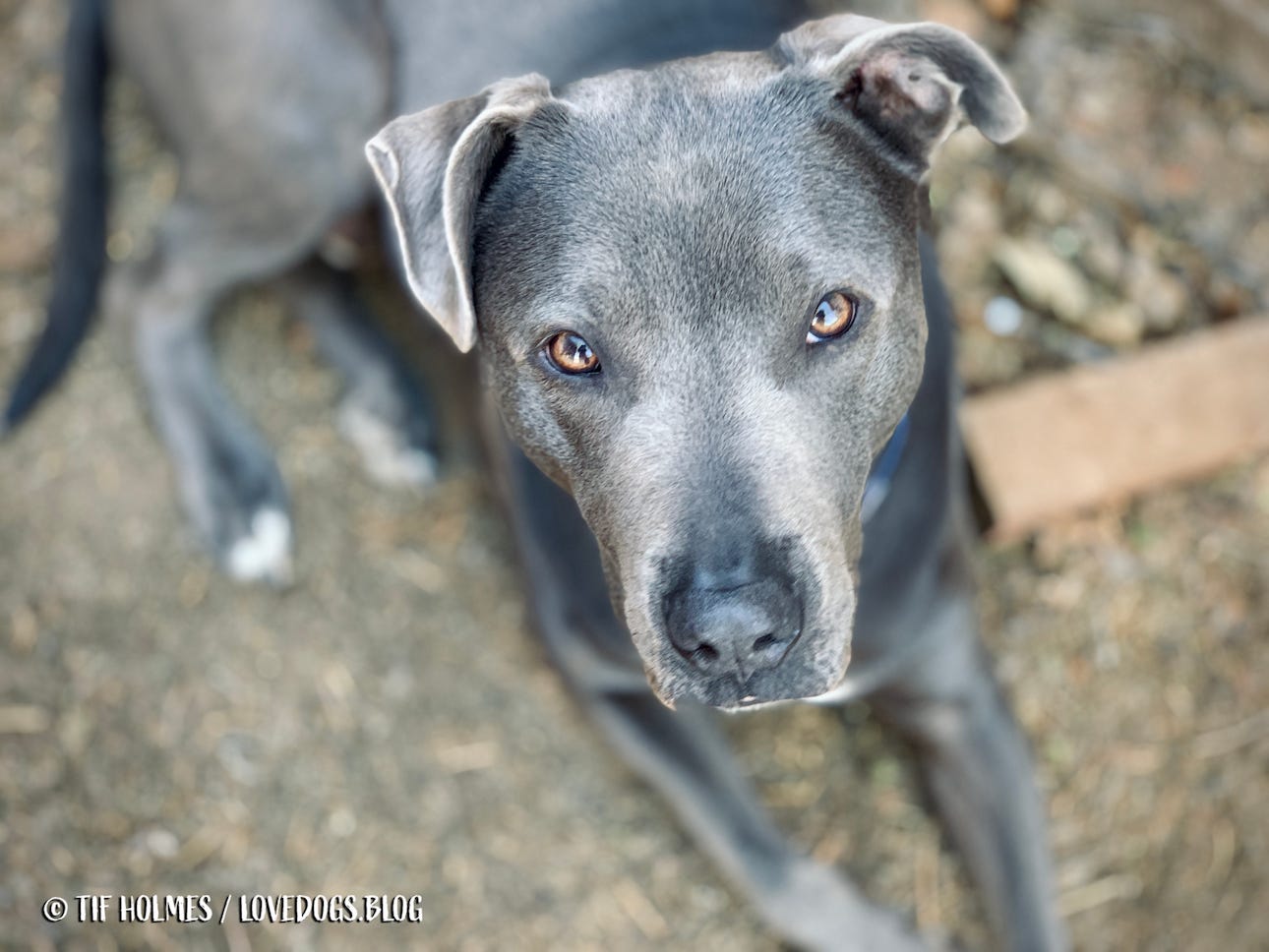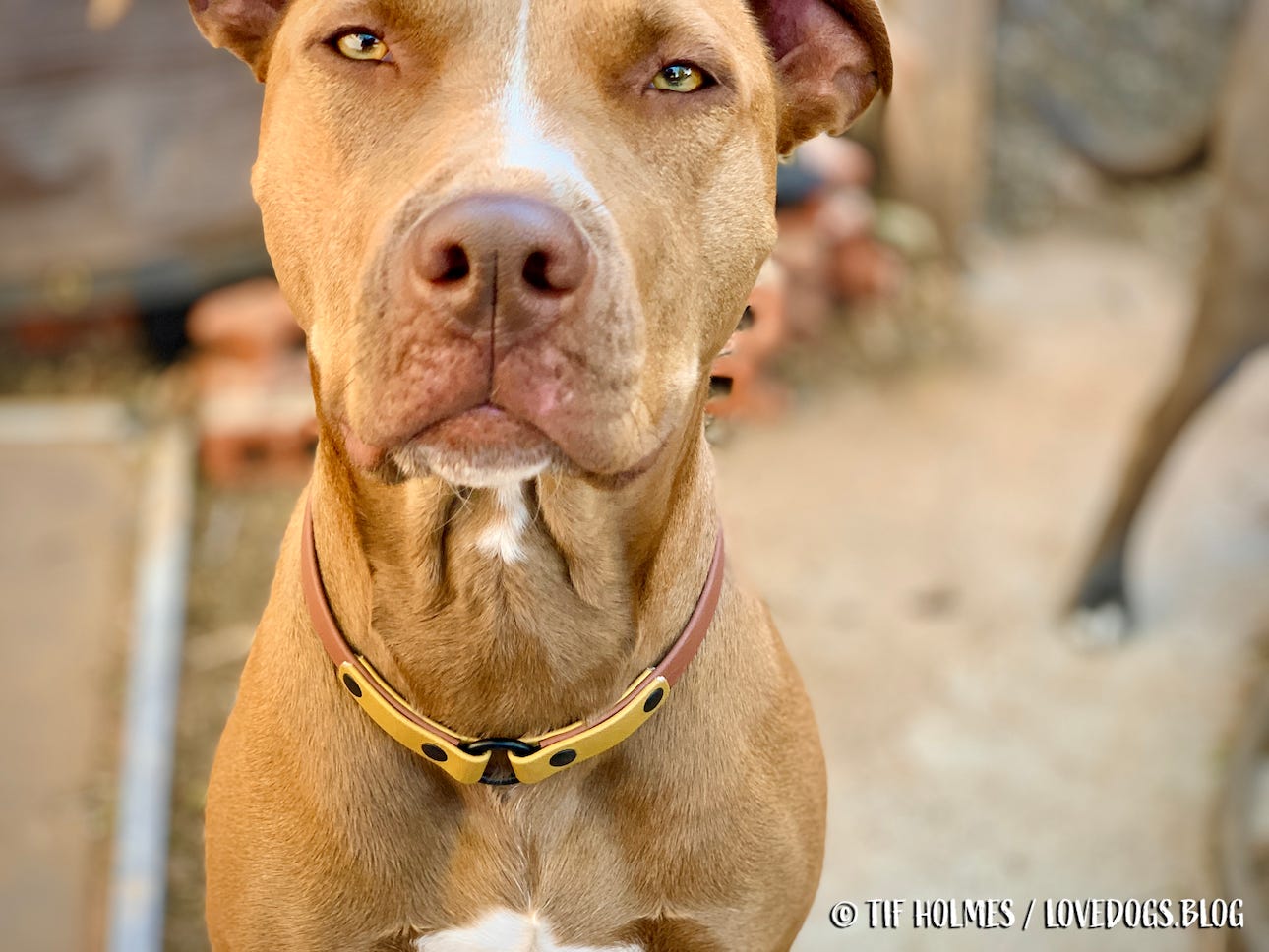"Calm" as an Embodied Cue
During the externship phase of my dog trainer certification last year, I had the opportunity to test a cue that I’d been using at home with Japhy and Hazel to see if it works with overstimulated dogs in a shelter environment. Those of you who have been reading this blog for awhile may recall Oprah, one of my shelter favorites. She was a challenge to get out of her kennel because she would become so overstimulated by my presence (and all of the other dogs barking at my presence) that she would bite at my hand as I put the lead around her big bully head. When I first started working with her, she would jump at my sweatshirt, biting at it and grabbing skin in the process. To some, this might seem like aggression, but it was actually just overstimulation. And it’s not uncommon, especially in shelters.
It’s reasonable to think that creating a calmer environment is one of the first steps to creating a calmer dog. In training, we call this Antecedent Arrangement, or Environmental Management. In some shelter systems, however, there will always be an element of chaos in the sheer number of dogs in close proximity, all barking relentlessly for a variety of very understandable reasons. Sometimes we can take a dog outside or to another part of the property to work with them, but we simply cannot remove the stress entirely. So when we work with a dog, we have to find other ways to create a calmer environment, however small.
If you’re interacting with a dog, whether at home, on a walk, or in a shelter, then you are a part of that dog’s environment, and how you engage with them becomes part of your Environmental Management. For example, if you approach a dog in a very excited manner, chances are the dog’s excitement level will increase exponentially. If they’re easily overstimulated, this may cause them to act out (chewing, jumping, nipping, etc.). On the other hand, if you approach a dog very calmly, there’s a much higher probability that they’ll respond more calmly.
I’ve mentioned before that I’m not a fan of people speaking to my dogs in a high-pitched playful voice. It’s one of the quickest ways to get both dogs from 0 to 100 in two seconds, and I actively work to prevent that when we’re in public. There’s a time and place for excited play, and as my dogs’ handler and guardian, I choose that time and place. I’ve become well-practiced at respectfully asking strangers to speak normally and calmly to my dogs or ignore them altogether. Some people look at me as if I just ruined their day, but I smile knowing that my dogs remained calm and well-behaved because I advocated for them.
A couple of years ago I started saying “calm” in a soft, slow, very low-energy tone to both of my dogs any time they started to get riled up. In addition to saying it, I reflected the energy of the word in my body language and presence. If I touched the dogs, I reflected the word “calm” in my touch. It was instinctual, and it worked. Since then, I have used this regularly with my own dogs, as well as with private clients and shelter dogs. It’s simply taking a way of being and putting a word to it for dogs to use as a signal that they should comply with the desired behavior. In short, it’s a cue. But it’s more than that. It’s an embodied cue. And it does just as much for the human embodying it as it does for the dog complying with it.
I’ve said before that my previous dog, Mani, taught me a lot. She was my first “difficult” (or as my veterinarian likes to say, “special needs”) dog. Japhy and Hazel continue to teach me and mold me into a better human. I choose to adopt and work with these “difficult” dogs precisely because of how much they teach me about myself and how to live more compassionately and mindfully. But, truly, the single most significant thing I’ve learned from them all is how to chill the f*ck out. I say this with a bit of humor, but I’m serious. People have told me that Japhy is a lot calmer than he was a year ago. Let me tell you, *I’m* a lot calmer than I was eight years ago, and I have my dogs to thank for that.
When it becomes obvious that our emotions feed our dogs’ behavior, it can (should?) act as a catalyst for change. For example, once when Japhy and I were staying with my parents (pre-Hazel), my dad and I got into an argument. It got pretty intense, and before I realized it, Japhy had jumped off the couch and positioned himself between us, facing my dad and barking at him. That was my wakeup call. Since then I’ve worked hard to recognize my own triggers and to redirect myself when needed. Isn’t it interesting how so much of “behavior problem solving” in dog training is effective for humans as well?
Returning to Oprah’s story: I started using the “embodied calm” with her, realizing that it was me against an entire lot of overstimulated, barking dogs, and thus keeping my expectations in check. After a few sessions I actually started seeing a difference. There was less biting at my hands when trying to put the lead on her, and any time she would attempt to jump up and mug me on our walks, I’d give her a quick correction with the lead, stop walking, and tell her, “calm,” in my most relaxed voice and body posture. After a few weeks of consistently using this new embodied cue, there was a noticeable change in Oprah’s behavior. She still had her crazy moments, but generally speaking, Oprah was becoming a calmer dog.
Now, Oprah is in a home of her own with a person of her own (yay! 🎉), and I suspect she’s doing quite well. All she really needed was to get into a calmer environment, where she could learn other ways of behaving and engaging with the great big world. All she really needed was a human who was willing and able to offer her that chance.
It’s all any dog needs and deserves.
Take care, friends. Be well and embody calm. For the dogs and for yourself.





I am so glad I stumbled across your stack...your post is so well written and thought-out. I am momma to a lab/pit mix who challenges me often. He's flat out stubborn and it has taken a lot of energy to get him to calm down over the years. He is overly people-loving and excitable. People don't often like when I tell them no, they may not pet him or to not get him excited, it's for HIS good. When I correct him sternly, it's for HIS good. (And mine since he's strong as an ox.)
Happy to restack and add your posts to notes. I'm new to this platform and am also just reaching out to connect with others along the same line of thinking. Blessings!
Beautiful Tif. So well said. And straight from the heart.❤️